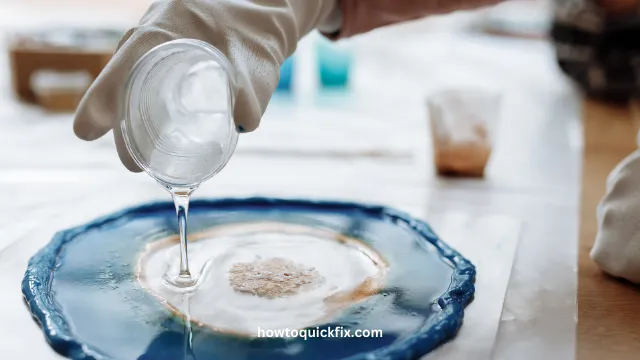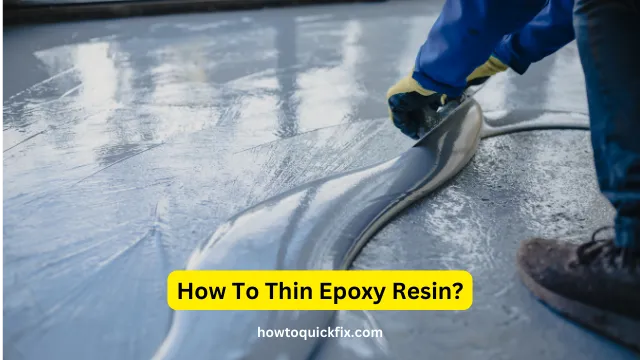Epoxy resin is a versatile material with endless applications, from crafting stunning art pieces to building durable surfaces. However, sometimes its thick, viscous consistency can be challenging to work with, especially when you’re aiming for a smoother, more precise application. This is where learning how to thin epoxy resin becomes invaluable.
Thinning epoxy resin isn’t just about ease of use; it’s about achieving the perfect finish for your project. Whether you’re an artist, DIY enthusiast, or a professional, understanding the right techniques can save you time, reduce waste, and ensure the durability of your work.
In this blog, we’ll dive into safe and effective methods for thinning epoxy resin. By the end, you’ll be equipped with the knowledge to master your resin projects with confidence and achieve exceptional results every time. Let’s explore the art of working smarter, not harder, with epoxy resin!

Contents
1. Why Thin Epoxy Resin?
Thinning epoxy resin is essential for certain projects where a smooth, even application is required. A thick resin can create uneven layers and bubbles.
When working with intricate molds or pouring thin layers, a less viscous resin flows more easily and fills in gaps. This ensures a flawless finish without imperfections.
Thinning also helps when applying resin as a sealant or primer, allowing it to penetrate porous surfaces like wood for a stronger bond.
2. Methods to Thin Epoxy Resin
There are three primary ways to thin epoxy resin: heat, solvents, and specialized additives. Each method has its pros and cons.
Heating resin temporarily reduces viscosity, making it easier to pour and spread. However, it can accelerate curing, so you must work quickly.
Adding solvents like acetone or isopropyl alcohol thins the resin effectively but may compromise its strength and clarity if overused. Specialized additives, on the other hand, are formulated to maintain resin properties while reducing thickness.
3. Using Heat to Thin Epoxy Resin
Heat is the most straightforward method to thin epoxy resin naturally. Warm your resin and hardener by placing the bottles in warm water for a few minutes before mixing.
Ensure the water is not boiling, as excessive heat can damage the resin and shorten its working time. Stir gently to prevent bubbles.
This method preserves the resin’s chemical integrity, making it ideal for projects requiring high durability and clarity. However, avoid overheating, as it may cause premature curing.
4. Thinning with Solvents
Solvents like acetone or denatured alcohol are effective for reducing viscosity but should be used sparingly. Add only 5-10% solvent to the resin mixture to prevent weakening.
This method is best for projects where strength isn’t critical, such as artwork or decorative items. However, overuse can lead to a brittle or cloudy finish.
Always ensure proper ventilation when using solvents, as they release fumes. Follow safety guidelines and test a small batch before committing to larger projects.
5. Precautions and Best Practices
When thinning epoxy resin, always follow the manufacturer’s guidelines. Using incompatible solvents or excessive heat can ruin the resin’s performance.
Work in a well-ventilated area and wear protective gear, especially when using chemicals. This prevents exposure to harmful fumes and skin irritation.
Lastly, test your thinned resin on a small, inconspicuous area of your project. This ensures the results meet your expectations without risking the entire piece.
Conclusion
Thinning epoxy resin is a valuable skill that enhances your ability to create flawless and professional-quality projects. By choosing the right method—whether heat, solvents, or additives—you can tailor the resin to your specific needs without compromising its properties.
Remember that moderation is key. Over-thinning can weaken the resin and lead to undesirable results. Take time to experiment and find the best approach for your unique application.
With the techniques and tips shared in this guide, you’re now equipped to handle epoxy resin like a pro. Embrace the process, stay patient, and watch your creative visions come to life with ease and precision!
FAQs
Why would I need to thin epoxy resin?
Thinning resin improves its flow and spread, making it ideal for intricate molds, thin layers, or sealing porous surfaces.
Can I use any solvent to thin epoxy resin?
No, only use recommended solvents like acetone or isopropyl alcohol in small amounts. Other solvents may damage the resin.
Is heating epoxy resin safe?
Yes, warming resin is safe if done carefully. Use warm water, not boiling, and avoid overheating to prevent premature curing.
Will thinning affect the durability of epoxy resin?
Excessive thinning, especially with solvents, can reduce the strength and clarity of the resin. Always use moderation.
Can I thin resin after it’s mixed?
It’s best to thin resin before mixing with the hardener to ensure even consistency and proper curing.
How do I avoid bubbles when thinning resin?
Stir gently and use heat sparingly to release trapped air. Using a torch or heat gun after pouring can also remove surface bubbles.








